WxGUI Map Swipe: Difference between revisions
Jump to navigation
Jump to search
m (→Introduction: link wxGUI page) |
(→Introduction: possible enhancements) |
||
| Line 18: | Line 18: | ||
* zooming, panning | * zooming, panning | ||
* maps are loaded automatically when opening Map Swipe with two selected raster maps in Layer Manager | * maps are loaded automatically when opening Map Swipe with two selected raster maps in Layer Manager | ||
Possible enhancements: | |||
* add simplified layer manager for each window so that you can add any maps (raster/vector) - would it be useful? | |||
* add your idea here | |||
== Disaster analysis == | == Disaster analysis == | ||
Revision as of 16:39, 16 August 2012
Introduction
The Map Swipe is a wxGUI application which allows GRASS users to interactively compare two raster maps of the same area by revealing different parts of the raster maps. It is useful e.g. for comparing raster maps from different time periods. See also the manual.
The Map Swipe is available in GRASS 7 from the menu
File -> Map Swipe
and will be backported to GRASS 6 after some testing.

Implemented features:
- orientation of the swipe line can be changed (horizontal or vertical)
- zooming, panning
- maps are loaded automatically when opening Map Swipe with two selected raster maps in Layer Manager
Possible enhancements:
- add simplified layer manager for each window so that you can add any maps (raster/vector) - would it be useful?
- add your idea here
Disaster analysis
The Map swipe tool is particularly interesting for pre and post disaster analysis of satellite or other images.
Screenshot of map comparison:
